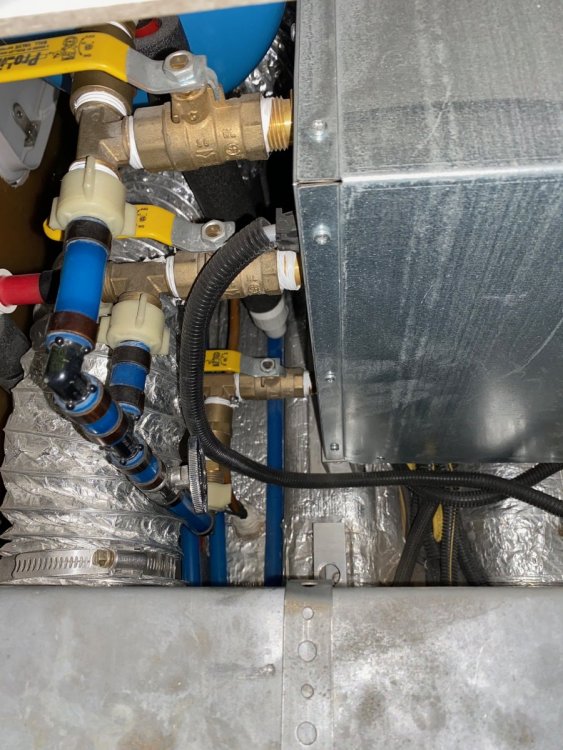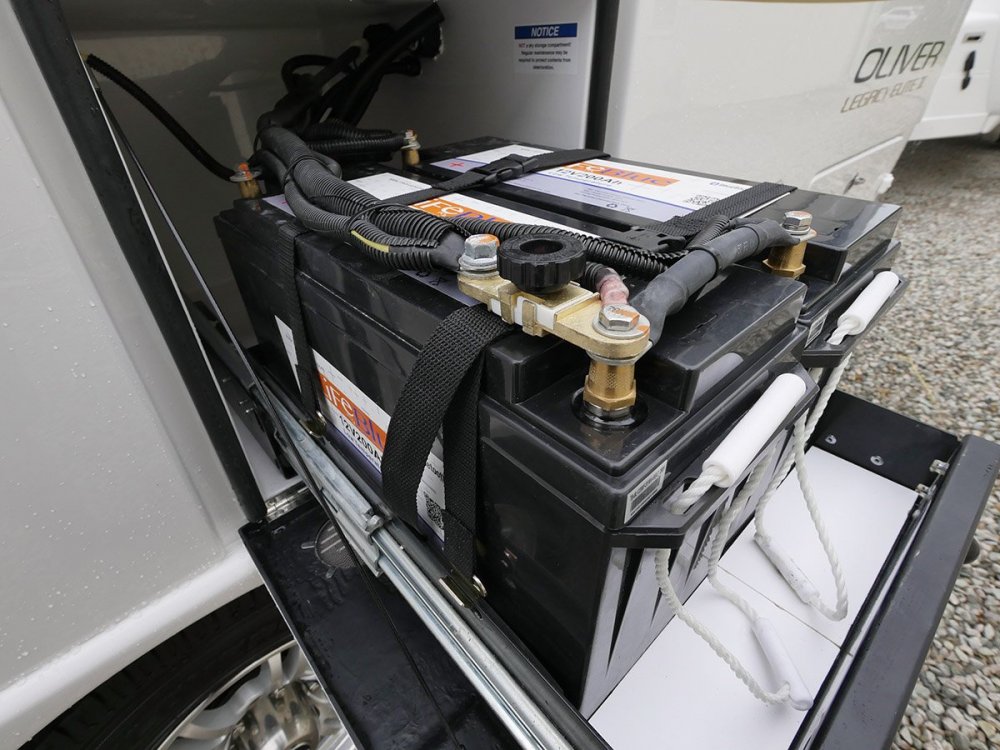-
Posts
3,835 -
Joined
-
Last visited
-
Days Won
212
Everything posted by Overland
-
- 19 replies
-
- 5
-

-

-
I need to amend this comment slightly. One of the finicky things that we've had problems with on the Truma is getting consistent hot water out of it. Sometimes it's hot, sometimes warm, sometimes frigid, and often during a shower you get all three. Not great. Well, as part of my plumbing renovations, I'm thinking about swapping out all of the plastic pex fittings with brass, and while I was counting fittings this afternoon, I was staring at the connections at the Truma and just had to laugh when the mistake that's causing my problems was suddenly obvious. On my unit there are three connections: cold water goes in the bottom, hot water out the top, and the circulation return is in the middle. Let's see if you guys can spot it, too (the blue pex you're looking at is the winterization bypass). 🙄 😂 I can't be too hard on Oliver for this one, since mine was the first unit with the circulator that they installed. But I was told that there's one other Ollie out there with the same unit, that was on the line next to mine - so I'm sure it has the same problem.
-
Per my post above, I think the only way to work out solar and battery needs, without ending up in circular confusion, is to start with how much electricity you think you’ll use each day on average. Of course if you’ve camped before with a trailer, you probably have a good idea of what that is already, and if not, then the 70-80 Ah number seems to hold true for Ollie owners. From there you want a Plan A and Plan B for recovering that power. Plan A is again based on averages - size your solar to give you enough juice to replenish your batteries each day. The variables there will be your planned usage of course, but also when and where you plan to camp. Once you’ve done that, then you need a Plan B for when you’re camped under trees for three days or hit a stretch of rain and your solar can’t keep up. If you try to size your solar for that, then you’ll need a second trailer to hold it all. For most people, Plan B is a generator, which has the added benefit of being able to power your AC. But if you’re trying to go without a generator like me, then instead you plan your battery bank to get you through those days. For me, that means 3-4 days of battery storage, hence the size of my battery bank. It’s a simple problem if you think of it like that. Don’t overthink it, and don’t for a second think that just because someone is doing X that you have to do the same. Take the time to think about your individual camping habits and needs. But having said that, I think that Oliver’s standard AGM or lead acid batteries and solar package is sized correctly for 80% of buyers. The other 20% are either people like me, or the opposite - people who never camp without hookups and don’t need solar at all.
- 19 replies
-
- 2
-

-
Continuing that line of thought, I actually enjoy sleeping in a tent, possibly more so than the Ollie. What I dislike about tent camping (mainly) is the setting up and taking down. A rooftop tent solves that issue for the most part, but the problem with living with one of those is all the rest of the campsite gear that has to be pulled out, set up and then taken down the next morning so that you can use your vehicle for the day, That’s fine if you’re traveling from A to B to C each night, but because of the density of parks and scenery, people don’t really ‘overland’ like that in the US - we tend to camp in one spot for two or three days, explore the area, then move on. Anyway, my wife would hate this idea, but I’ve wondered how well it would work to think of a shorty Ollie as a sort of luxurious chuck wagon. Kit it out for storage and daytime use, but not necessarily for sleeping.
-
I still think that the sealant got stained rather than UV damage, though that’s mostly a guess. I wouldn’t draw any conclusions unless more people post about it. I think it’s something for recent owners to look for and hopefully post back with their experience. I will say though that after trying to clean it off, I’d prefer a non-silicone sealant. It’s not terrible, but a good bit more difficult than the original. I’ve gone back with the 3M 4000UV, and we’ll see how long it lasts and how clean it stays.
-
I think an Ollie plus a rooftop tent on the tow vehicle for the kids would be a pretty nice way to travel. You get all the conveniences of the Ollie, and the kids get their own space plus maybe a bit more sense of adventure.
-
David, I just noticed that Oliver is showing a terminal disconnect on the photo for their new LFP package. They might be able to tell you what brand and model they're using.
-
If I bring my trailer over, will you finish the plumbing work I started? Also, it could use a coat of wax.
-
Here's another thought on the solar/lithium question, which is that personally, I think that the new F150 with a built-in generator adds an interesting new kink to the equation. I'm a big proponent of solar, and my goal with our trailer was to be able to go without a generator - and we've been quite successful with that - however, if I were buying a new truck today, like I did when we bought our Oliver, and that truck already came with a nice built in generator, I'd give much more thought towards putting my money somewhere else other than solar and a large battery bank. I mean, let's face it - if you have a generator then you don't need any more solar or battery than Oliver's standard offering. Especially with the quick charge capabilities of LFP batteries (I can charge at 120 amps), I think I could easily keep our batteries charged with 30 minutes of generator time a day, even with half the solar we currently have. Most days, surely less. Divide that into 15 minutes in the morning and 15 at night, and that's really not that much generator noise and fumes to endure. And if you've got a generator sitting there that you don't have to drag out, gas up, etc., that makes the option of using one much more tempting. I think if I were configuring my trailer today, I'd do the standard packages with the cheapest battery offering, and I'd replace the batteries with 200Ah of LFP, maybe 300, and then rip out the electrics and replace it with all the same Victron stuff I've got now.
-
1. Do we need 1000w more inverted power? You would need it if you want to run the AC for a short period without running a generator - for example, at a rest stop for lunch. It might also help when running 2 appliances at once, though my experience is that the second appliance almost always pushes you over. But it's allowed us to do things like install a 120v stereo system without having to worry if that plus the toaster oven or coffee maker will overload the inverter. 2. AGM - 220 available ah (440ah @ 50% discharge) Lithium - 340 available ah (400ah 85% discharge) Would we use 120 additional ah? I get 90% out of mine, for 360 Ah but I can't say if Oliver's batteries will be the same. 3. Battery life: Lithium = 2x AGM life? More like 3 times. 4. Cost of battery replacement - 2 lithium vs 4 AGM? times 3 5. Weight - not sure of the differential between Oliver supplied 4 AGM and 2 Lithium. It's roughly half the weight 6. Maintenance, monitoring etc - no experience with lithium If the batteries Oliver sells are like my Battleborns, then maintenance is zero. They have built in electronics that prevent overcharging, draining, etc. 7. Solar battery charging - our RV experience has been with 200w flat panel (inefficient?) solar panels with two 12v flooded house batteries, mostly in marginal sun exposure. This setup barely kept batteries topped off with basic onboard draws, including macerator toilet and no additional inverter usage. See this post - 8. High watt power usage would be appliances - toaster oven (1800w), inverter burner (100-1800w), electric kettle (1500w), hair dryer (1800w). No microwave and would use generator for necessary AC. Other power demands - lights, LP ignition, fans, water pump, cell phone and electronics charging, phantom draws. We only occasionally use TV. The additional power supplied by the lithium package is attractive, though I'm sure we could manage just fine without it; the solar package would certainly be a definite improvement over our current system. Is it worth $3,600 for power we might not use? Only you can say.
-
Not everyone. 100% of Oliver owners do. Or if they don't, they've made a terrible mistake.
-
OK, I missed that. If they've removed both the nightstand outlets and the ones under the beds, then yes, that qualifies as just outright stupid. They need to have at least one floor level outlet within easy reach of the bed area.
-
yes.
-
I'm unclear what the omission is.
-
I had already drilled two holes in mine before I left Oliver's parking lot. 😂
-
I still don't get the insistence on nightstand outlets. Who wants to sleep with their head up against an electrical outlet? The ones beneath the bed are handy enough. Even Apple's stingy power cords can reach there.
-
Yeah, 50 hours would mean that they're less efficient at it than I was when I did mine. And I really had little clue what I was doing.
-
That's a lot of labor for just a battery swap. I assume that's Victron batteries and separate BMS?
-
Just to address the original question, provided the LFP batteries you buy have a built in BMS like the battleborns, then they can be dropped in and will work fine with the standard charger, inverter, and solar charge controller. They do make an LFP specific charger, but I don't think the charge profile is that much different and battle born at least has said that the standard charger is fine to use. And even if you want to swap that out later, you can and it's neither difficult nor costly - there's a post or two here on the forum on what's involved.
-
My trailer wasn't able to go through the normal prep before delivery and yet it was still clean inside, apart from some residue on a few spots that felt like paint overspray. I'm wondering if they either missed the prep, or the trailer sat for a while in the factory afterwards. The factory itself is pretty dusty. It could be that you have dust between the hulls, or even in the air ducts or AC that's being blown out into the interior. That's something that has been brought up in the past, and has been a concern with some people with allergies. Mine was pretty dusty between the hulls. I've taken a couple of passes at vacuuming up dust and wiping things down within the hulls wherever I can reach, and while I wasn't getting visible dust inside, that definitely reduced the fiberglass smell significantly.
-
Yes it definitely pays to have a few key spares on hand. My regulator has gotten stuck a few times as well, but so far I’ve had good luck with either the whack-it-with-a-wrench or the open-and-close-the-tanks-a-dozen-times methods.
-
Here's a really good interview with the designer of the Bronco. As a designer myself, I ordinarily can't stand to listen to other designers because the BS factor is so obvious. This is especially so with automotive designers since cars are generally 'styled' from the outside in, around a platform that was dictated by engineers, and listening to the designers try to obfuscate that fact with incoherent language just makes me cringe. But this guy I like. He's down to earth, talks in language that is clear and concise, and is obviously someone who approaches design from a functional standpoint first. Anyway, interviews are always dry, but even if you aren't into design talk, he reveals some cool tidbits about the truck that are worth the time to watch.
-
When I spoke to some Earthcruiser owners at overland expo a few years ago they told me that they used a gps system that allowed them to input their max height and then it would only give them routes that allowed that clearance. I want to say it was a garmin system but I don’t really remember.
-

Thoughts on installing Victron SmartShunt battery monitor
Overland replied to GraniteStaters's topic in Ollie Modifications
That looks like the same crimper I have. I got mine on amazon for ~$50. I’ve definitely gotten my money’s worth out of it and it hasn’t shown any sign of wear. It had some reviews saying it broke easily but then what amazon product doesn’t. Overall the reviews were good. The only thing I don’t like about it is that you need three hands sometimes to use it. I wish it had a little stand that would make it stable on the ground so that you can easily hold the cable with one hand and operate the crimper with the other. -

Thoughts on installing Victron SmartShunt battery monitor
Overland replied to GraniteStaters's topic in Ollie Modifications
I agree on the crimps. Some people do both, crimp but leave some exposed copper and solder that. Supposedly the solder seeps into the crimped area for a better bond. That may be the case for bad crimps, but I found with a hydraulic crimper that the crimp is so tight that the copper strands are practically fused together, so I think soldering would just be a placebo. A hydraulic crimper is a worthwhile investment.





